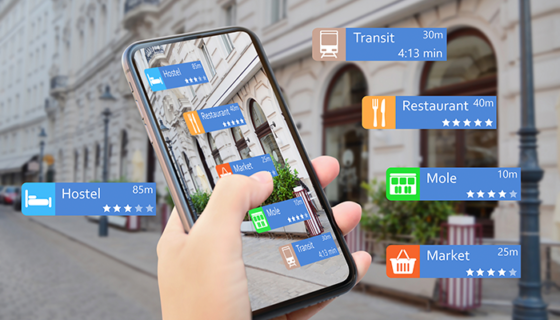Beyond the Expected: Real-Life Business Uses for Augmented Reality

The phrase "You have got your head up in the clouds" is no longer an insult in today's world -- having your head in the clouds may be the best way forward in business! Of course, I'm talking about Augmented Reality (AR); a transformative, disruptive digital technology that has been gaining traction for years and looks to be continuing its exponential growth trend in the years to come. What was originally viewed as only a feature to interactive video games of the future has now made its way into a multitude of industries, and now there are even more opportunities for entrepreneurs and business leaders to leverage AR in advantageous ways.
Bear in mind, it is not always a specific product or service that advances in AR pertain to. Oftentimes, it is industry-level disruption caused by transformative technologies like Augmented Reality, niche applications of AR that bring new sectors of an industry into the spotlight, or Hard Trend future certainties surrounding AR that businesses and organizations should be examining closely to find a way to leverage before someone else does.
So put on your favorite set of smart glasses and get ready to look closely at some of the most common current trends of AR coming our way in the next year or so! As you explore these topics below, I encourage you to think exponentially about how they can be beneficial to your operation.
Retail and Cosmetics Industry -- Try Before You Buy
Even to this day, department stores have areas where men and women can smell perfumes and colognes; try on pants, shirts, swimwear, and other apparel items; and even sample hand creams for consistency and smell. These are all sensory activities that trigger an emotion in a consumer to either purchase the product or to better understand what they don't want.
Augmented Reality applications have already started to emerge in this capacity, as witnessed with companies like Warby Parker utilizing the software to allow customers to "try on" frames they select from their app. Additional to eyewear, AR applications also have stemmed into the apparel industry and more recently, the cosmetics industry. An individual interested in lipstick and blush can see how those colors work for them in similar fashion to trying on frames through Warby Parker.
On a human level, this allows businesses and manufacturers to connect with customers on a more personal level, in that they allow them to see what they would look like in apparel or cosmetics without being in public. Believe it or not, this dabbles in my Skip It Principle in unique, exponential ways. Many customers have trouble trying things in front of potential strangers, so AR applications give them a new level of personal privacy in doing so.
Digital Humans and Avatars -- The NEW Influencers
If you work in marketing at any size organization of any industry, you are likely familiar with the term "influencer marketing." If not, let me shed some light on the matter. Influencers are public figures that endorse a brand, just as a professional athlete endorses a pair of sneakers or a musician endorses a specific guitar.
But what about digital influencers, and better yet, digital humans that endorse real products to real people? The Metaverse is a digital universe that AR and Virtual Reality (VR) applications operate in, and within that Metaverse, human beings exist in the form of an avatar. Overseas and around the world, avatars that emulate digital human beings are on the rise in multimedia marketing, interacting with customers on a personal level in the Metaverse as product influencers.
What is further? Consider digital humans selling digital products to real humans in the form of non-fungible tokens (NFTs) -- a concept I recently explored in a previous blog. If you feel this all to be too "out of this world" for your industry, think again. Marketing researchers estimate that the digital human industry alone will be worth billions in just a few years, opening a veritable vault of opportunity for industries to capitalize on this Augmented Reality concept.
Don't Lose Yourself -- Augmented Reality and Our Both/And World
Digital human beings, virtual changing rooms many are asking with panic, "What has this world come to?!"
Are we losing ourselves in all of this digital technology? Maybe to some degree but staying human in the digital world and finding ways to better the human customer experience with digitally disruptive technology like AR is up to us! Doing so is accomplished first by understanding my Both/And Principle found in my Anticipatory Leader System.
The Both/And Principle focuses on the reality that something new and potentially disruptive may transform the way things are done but will in no way completely erase where we have come from. Especially as it pertains to digital humans and avatars, AR applications will not completely replace the human, tactile experience of trying on clothes or interacting with other human beings.
Trying on cosmetics may be simply done using AR filters and applications, but where AR and VR fall short is in other human sensory areas, including smell, taste, and touch. Until your mobile device screen can emulate how a pillow feels or spritz some cologne on your wrist for sampling, the physical world of consumer experiences is still there and is very valuable.
The two Augmented Reality concepts explored in today's blog are meant to enhance the customer user experience, not completely replace the old. Additionally, these concepts have Hard Trend future certainties that all business leaders and C-suite executives can leverage in their specific industry. Thinking in terms of a Both/And world brings clarity to your Futureview and how you can use AR and applications of it to positively disrupt and transform the world.









